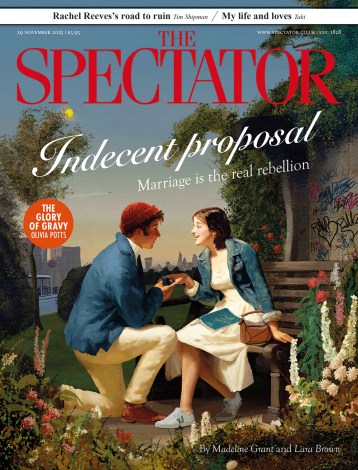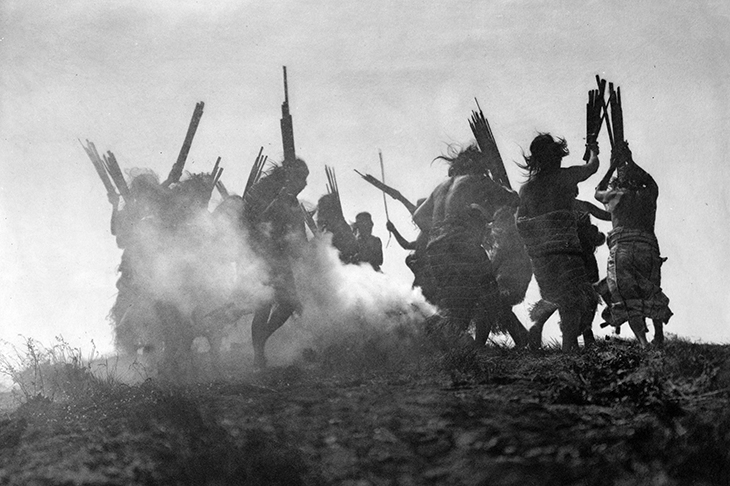Edward S. Curtis’s 1914 photograph, ‘Dancing to Restore an Eclipsed Moon’, shows the Kwakiutl tribe of North American Indians circling a fire ‘to make a sky creature sneeze and disgorge the moon’. Raised arms are silhouetted against the sky, faces remain imperceptible, and bodies are shrouded in smoke. It is apt that such a mesmerising image should accompany the opening chapter of Nina Edwards’s beguiling book, which gallantly aims to subvert common views of darkness, both physical and metaphorical.
Given the enormous scope of her subject matter (from clothing to Christianity, electricity to the Enlightenment, Islam to the Industrial revolution, black holes to Steve Bannon, and Milton to the moon), it’s perhaps inevitable that some topics receive rather scant treatment (on one page the jump from disembowelling to unlit coastal paths is somewhat unnerving). But, for the most part, Edwards’s approach is considered and engaging as she explores the curious paradoxes and possibilities of ethereal half-shadows and ‘umbral blackness’.As Van Gogh once remarked to his brother: ‘The night is more alive and richly coloured than the day.’
While the gradual introduction of electricity was regarded by many as a symbol of progress and a civilising force in the wilderness — ‘the lighter people’s lives could become […] the better all would be’ — others saw it as an enemy of the benefits of darkness. Edwards questions our desire to be ‘brightly and irrecoverably lit’ and quotes the writer Julian Hawthorne (son of Nathaniel) as suggesting it is the gentle light of the lamp, with its imperfection, impetuosity and limitations, which is ‘more in sympathy with this human nature of ours’.
Even before the arrival of electricity, the concept of light posed a threat to some. In ‘Ode to a Nightingale’, Keats mourned a lost rural idyll of darkness which stood in contrast to the brightened world in which he lived; and a fevered article in the Kölnische Zeitung newspaper from 1819 deems street lighting ‘an interference with God’s order’, its artificial brightness chasing from the mind ‘the horror of darkness that keeps the weak from many a sin’.
As the bright lights and torrents of information multiply in our modern, internet-riddled lives, it seems that, ironically, our capacity for self-knowledge diminishes. Our perception is so limited that Plato’s theory may still apply: we remain ‘shackled at neck and ankle’ in such a manner that we cannot see what is really going on. As we reach for our bright screens, hungry for more information, we remain blind to our more shadowy, and yet truer, selves.
If only we could get closer to our darker sides, our reservoirs of ‘human darkness’, as Jung called it, then we might find ‘the true spirit of life’. Just as Marlow’s journey into the jungle in Joseph Conrad’s Heart of Darkness might represent the uncovering of the character’s unconscious mind, so our attempts to piece together dreams might allow us to travel into the darkest regions of our psyche. Indeed, sleep (Samuel Taylor Coleridge’s ‘fiendish’ other life) presents an ideal state to give vent to our most primitive selves, and Edwards points to the paradox that the darkness of sleep can in fact ‘bring order and clarity to what was confusion’. Yet, according to the American poet John Hollander, it is the fragility and impermanence of human perception that adds to, rather than diminishes, the power of what cannot be clearly apprehended.
Just as Hollander suggests that shadow is an essential ingredient in poetry (‘it insinuates itself into our consciousness. It reflects our lives’), so artists in history have either embraced or failed to escape the elusive nature of art. Da Vinci was fascinated by the sfumato technique which, marking a departure from the vivid chiaroscuro style, engages in all the subtle tonal and chromatic shades that lie between darkness and light to create the illusion of ‘intimate humanity’. But Caravaggio’s attempt to achieve heightened theatricality in his ‘Madonna dei Palafrenieri’ by making the dark darker was lost on some, who saw the effect as mere ‘lack of respectful distance’. Meanwhile, for one art critic, the predominantly dark tones of Mark Rothko’s ‘Seagram Murals’ inspired liberation and peace rather than marking ‘a savage aesthetic revenge’.
It is Goya’s ‘The Half-drowned Dog’ which perhaps best represents the elusive wonder of darkness in art and life. With only its head shown on an otherwise strangely blank canvas, it simply evades definition. ‘It is a symbol that cannot be explained,’ Edwards says, ‘suggesting a metaphor that cannot be unpacked, lost in the dark without the grounding of tenor, so that we are left floating in uncertainty.’
Marking Edwards’s latest work to embrace the neglected and the obscure (previous offerings include weeds, buttons and Offal: A Global History), Darkness leaves the reader floating, too — but full of conviction that truth and beauty can still exist, to quote Edward Lear, ‘when awful darkness and silence reign’.






Comments